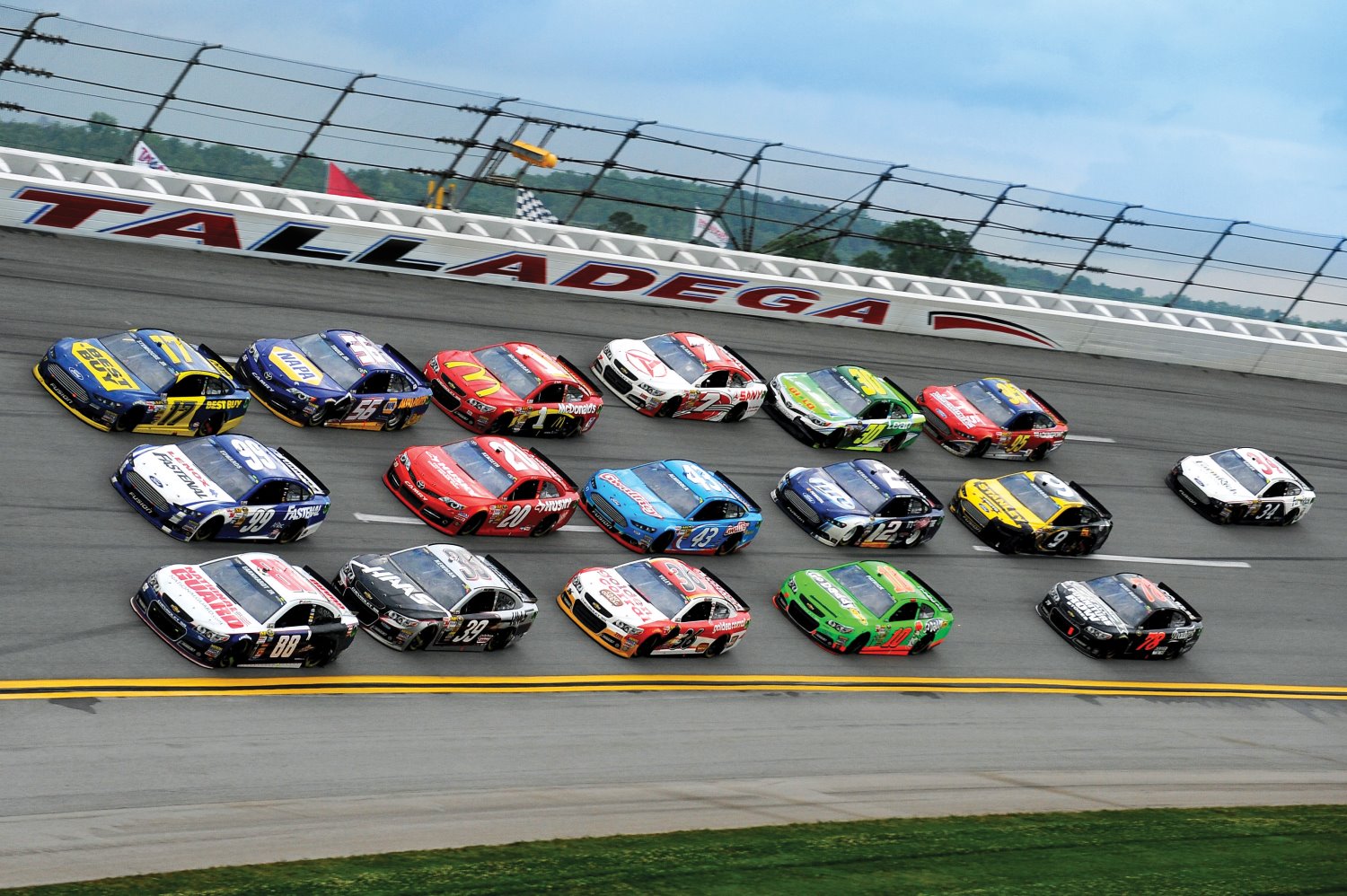Role of Crew Chief at Talladega Pivotal
 |
| Talladega Pack Racing – An accident about to happen every lap |
With all the excitement around NASCAR’s competition changes for Talladega Superspeedway’s Aaron’s Dream Weekend, May 2-4, added pressure and a sense of urgency will now be felt like never before by the Crew Chief and team engineers who set up the cars and make the hard decisions at NASCAR’s biggest and most challenging venue.
Two immediate changes – the new “Knockout" Coors Light Pole Award qualifying and NASCAR’s new Chase format where a driver has a chance to make The Chase with a victory – will place a premium on perfection where it concerns aerodynamics of the cars as well as the engines under the hood. It could mean the difference between winning or finishing 30th.
While the intensity will be turned up on the 2.66-mile, 33-degree banked mammoth track, the fans in the stands will be the real winners, witnessing 200 mph, four-wide, bumper-to-bumper racing like never before. While the driver will be key in piloting the car to a coveted victory, the man calling the shots prior to and during the race will play a pivotal role. Billy Scott, crew chief for the No. 55 Aaron’s Dream Machine of Brian Vickers, knows all too well what to expect.
“Talladega puts a premium on aerodynamics and makes us scrutinize everything on our Aaron’s Dream Machine," says Scott, who is in his first year as crew chief after serving as the team’s racing engineer in 2012 and 2013. “In the weeks before a race, our team at Michael Waltrip Racing will massage and tweak our cars to perfection. Priority one at Talladega is reducing drag. As the car is going down the backstretch, drag is the force that slows it down. We want our cars to slice through the air.
“To do that we’ll go to crazy lengths in the way we build our cars even making sure the bolts we use on the car glide through the air with as little drag as possible. At 200 mph reducing drag by even a fraction helps. We’ll take our cars to the wind tunnel to learn what works and what doesn’t work. We move the car’s splitter and work to keep the back of the car down so the spoiler isn’t up in the air which slows the car down. Heck, nothing is too small for us to consider. At Talladega reducing drag is critical."
Like many modern day NASCAR crew chiefs, Scott relies heavily on his own engineering background. In addition to aero, engine cooling will be important in both the Aaron’s 499 set for Sunday, May 4, as well as the new three-segment, group elimination qualifying the day before.
“Keeping the engine cool is a priority," added Scott, who hopes to give Vickers his second Talladega triumph. “If you notice, teams will put tape on the front of the radiator openings on the car’s nose. Taping over the openings creates far less drag, which means you’ll go faster. However, taping over the opening means your engine will run hotter. You can’t afford to have the engine overheat if you are caught back in the pack. It’s a tradeoff that the crew chief, engineers and drivers consider before and during the race. Tape means faster and hotter, no tape means slower but cooler."
Fuel Mileage won’t come into play during Knockout qualifying but it could in the Aaron’s 499, and calculating the correct mileage is huge. If a driver runs out of gas through the trioval, it is nearly 2.5 miles back around to the entrance of pit road – a disaster which will take lots of time, and in the process, cause the car to lose laps to the leaders.
“Usually fuel mileage is pretty straightforward at most of the tracks where we race, but what makes Talladega different is the draft," Scott admitted. “A car running by itself could use up to 10 percent more fuel than a car being sucked along in the draft. If you listen during the race, the crew chief will ask the driver how much he’s been in the throttle on that particular fuel run. He’ll tell you a bunch or not much and you’ll make fuel calculations based on that input. That’s the importance of communication between driver and crew. That can be the difference between winning the race and running out of fuel at the end."
This is why Scott’s anxiety level will be tested like no other track when he comes to Talladega.
To see what crew chiefs make the right calls, fans can get tickets to all three days of action for the Aaron’s Dram Weekend. On Friday, the NASCAR Sprint Cup Series cars will have two practice sessions for the Aaron’s 499, while the ARCA Racing Series drivers will practice and “group" qualify for the International Motorsports Hall of Fame 200. Also on Friday, the NASCAR Nationwide Series competitors will qualify for the Aaron’s 312 with the new Knockout format.
Saturday will be an incredible show with four major events! The International Motorsports Hall of Fame 200 will kick it off at 10 am CT, followed by the NASCAR Sprint Cup Knockout qualifying at 12:10 pm. At 2 pm, the NASCAR Nationwide Series will take to the 2.66-mile venue for the Aaron’s 312. When the track cools down country star Randy Houser will perform a concert in the track’s rowdy infield.
